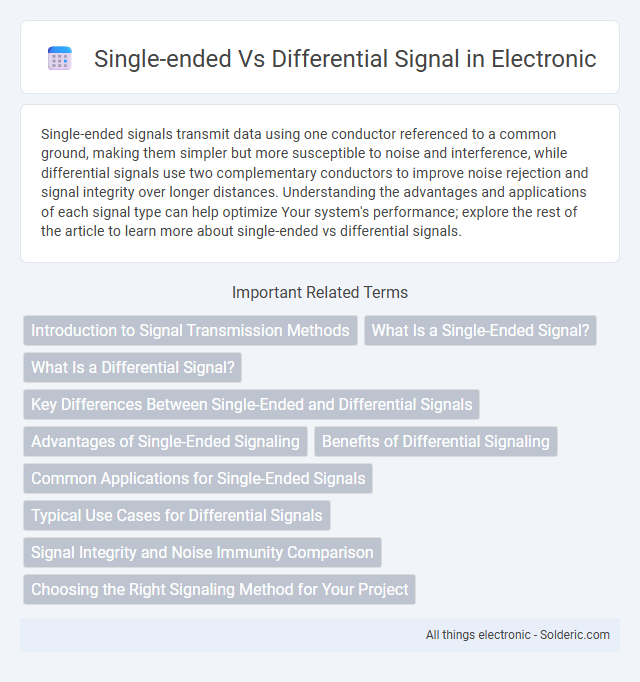Single-ended signals transmit data using one conductor referenced to a common ground, making them simpler but more susceptible to noise and interference, while differential signals use two complementary conductors to improve noise rejection and signal integrity over longer distances. Understanding the advantages and applications of each signal type can help optimize Your system's performance; explore the rest of the article to learn more about single-ended vs differential signals.
Comparison Table
| Feature | Single-Ended Signal | Differential Signal |
|---|---|---|
| Signal Type | One active conductor referenced to ground | Two conductors carrying opposite signals |
| Noise Immunity | Low, susceptible to external interference | High, cancels out common-mode noise |
| Voltage Swing | Standard single voltage level | Effective double voltage swing between wires |
| Crosstalk | Higher crosstalk risk | Lower crosstalk due to balanced lines |
| Complexity & Cost | Lower complexity and cost | Higher complexity and cost |
| Typical Applications | Audio signals, low-speed data | High-speed data, Ethernet, USB, HDMI |
| Impedance Control | Less critical | Requires precise impedance matching |
Introduction to Signal Transmission Methods
Single-ended signal transmission uses one conductor carrying the voltage relative to a common ground, making it simpler but more susceptible to noise and interference. Differential signal transmission employs two complementary signals carried on paired conductors, enhancing noise immunity and signal integrity over longer distances. This method is widely used in high-speed communication systems such as USB, Ethernet, and HDMI to ensure reliable data transfer.
What Is a Single-Ended Signal?
A single-ended signal transmits data using one conductor referenced to a common ground, making it simpler but more susceptible to noise and interference. This type of signaling is commonly used in applications where cost and complexity need to be minimized, such as audio equipment and basic sensor interfaces. Understanding the characteristics of single-ended signals can help you decide when they are appropriate for your design needs.
What Is a Differential Signal?
A differential signal consists of two complementary voltage signals transmitted over a pair of wires, where the information is conveyed by the voltage difference between these wires rather than by a voltage referenced to ground. This method significantly reduces electromagnetic interference (EMI) and crosstalk, enhancing signal integrity, especially in noisy environments or over long distances. Differential signaling is commonly used in applications like USB, Ethernet, and high-speed data communication to achieve higher noise immunity and improved transmission performance compared to single-ended signals.
Key Differences Between Single-Ended and Differential Signals
Single-ended signals use a single conductor referenced to a common ground, making them more susceptible to noise and signal degradation over long distances compared to differential signals, which transmit two complementary signals on paired conductors. Differential signaling offers improved noise immunity and higher signal integrity by measuring the voltage difference between the two wires, effectively canceling out external interference. Your choice between single-ended and differential signals depends on factors such as required noise tolerance, transmission distance, and application-specific data integrity needs.
Advantages of Single-Ended Signaling
Single-ended signaling offers simplicity and cost-efficiency by using a single conductor and ground reference, making it ideal for short-distance communication and low-speed data transfer. Your system benefits from reduced complexity in circuit design and easier troubleshooting compared to differential signaling setups. It consumes less power and requires fewer components, which is advantageous in compact or budget-sensitive applications.
Benefits of Differential Signaling
Differential signaling offers superior noise immunity by transmitting two complementary signals, allowing receivers to reject common-mode noise and interference. This method enhances signal integrity over long distances and high-frequency transmissions, reducing electromagnetic interference (EMI) and crosstalk compared to single-ended signaling. The equal and opposite currents in differential pairs minimize ground loop effects, improving overall system reliability and data accuracy in complex electronic environments.
Common Applications for Single-Ended Signals
Single-ended signals are commonly used in consumer electronics, audio equipment, and low-speed data communication where simplicity and cost-effectiveness are priorities. These signals transmit voltage referenced to a common ground, making them suitable for short-distance connections such as headphone jacks, RCA cables, and microcontroller I/O pins. Their widespread application in analog and digital circuits leverages ease of implementation despite susceptibility to noise over longer distances.
Typical Use Cases for Differential Signals
Differential signals are commonly used in high-speed data communication, such as USB, Ethernet, and HDMI interfaces, where noise immunity and signal integrity are critical. These signals excel in environments with electrical interference, like industrial automation and automotive systems, ensuring reliable data transmission over longer distances. Your designs benefit from reduced electromagnetic interference and enhanced performance when implementing differential signaling in these typical use cases.
Signal Integrity and Noise Immunity Comparison
Differential signals provide superior signal integrity by using two complementary voltages, which effectively cancel out common-mode noise and reduce electromagnetic interference, resulting in cleaner and more reliable data transmission. Single-ended signals, referenced to a common ground, are more susceptible to noise and interference, leading to possible signal degradation over longer distances or in electrically noisy environments. Differential signaling's enhanced noise immunity makes it the preferred choice for high-speed communication systems and applications requiring precise signal fidelity.
Choosing the Right Signaling Method for Your Project
Choosing the right signaling method depends on noise immunity and signal distance requirements; differential signaling provides superior noise rejection by transmitting equal and opposite signals, making it ideal for long distances and electrically noisy environments. Single-ended signaling uses a common reference ground, which simplifies wiring but is more susceptible to electromagnetic interference and is best suited for short, low-noise applications. Evaluating the project's environment, signal integrity needs, and complexity helps determine whether single-ended or differential signaling optimizes performance and reliability.
single-ended vs differential signal Infographic

 solderic.com
solderic.com